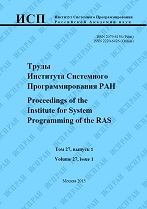|
This article is cited in 3 scientific papers (total in 3 papers)
Method for exploitability estimation of program bugs
A. N. Fedotov
Institute for System Programming of the Russian Academy of Sciences
Abstract:
The method for exploitability estimation of program bugs is presented. Using this technique allows to prioritize software bugs that were found. Thus, it gives an opportunity for a developer to fix bugs, which are most security critical at first. The method is based on combining preliminary classification of program bugs and automatic exploit generation. Preliminary classification is used to filter non-exploitable software defects. For potentially exploitable bugs corresponding exploit generation algorithm is chosen. In case of a successful exploit generation the operability of exploit is checked in program emulator. There are various ways that used for finding software bugs. Fuzzing and dynamic symbolic execution are often used for this purpose. The main requirement for the use of the proposed method is an opportunity to get input data, which cause program to crash. The technique could be applied to program binaries and does not require debug information. Implementation of the method is a set of software tools, which are interconnected with control scripts. The preliminary classification method and automatic exploit generation method are implemented as stand-alone tools, and could be used separately. The technique was used to analyze 274 program crashes, which were obtained by fuzzing. The analysis managed to detect 13 exploitable bugs, for which successfully workable exploits were generated.
Keywords:
vulnerability, buffer overflow, symbolic execution, exploit, binary code.
Citation:
A. N. Fedotov, “Method for exploitability estimation of program bugs”, Proceedings of ISP RAS, 28:4 (2016), 137–148
Linking options:
https://www.mathnet.ru/eng/tisp57 https://www.mathnet.ru/eng/tisp/v28/i4/p137
|

| Statistics & downloads: |
| Abstract page: | 182 | | Full-text PDF : | 123 | | References: | 34 |
|




 Contact us:
Contact us: Terms of Use
Terms of Use
 Registration to the website
Registration to the website Logotypes
Logotypes








 Citation in format
Citation in format 
